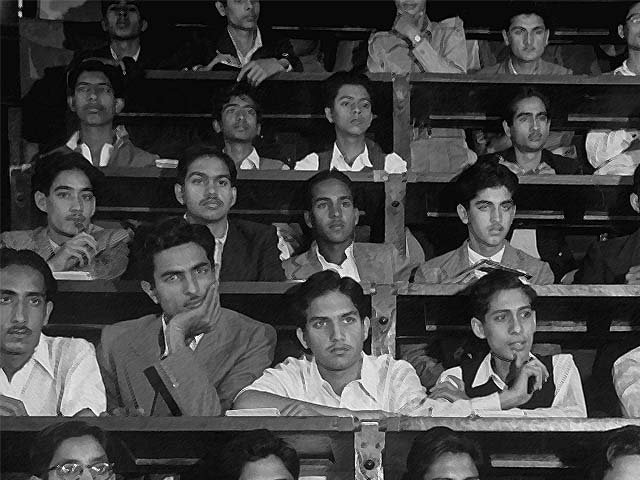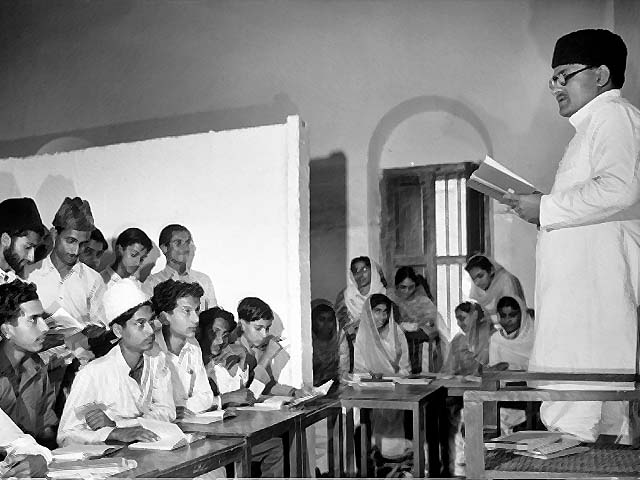
Pakistani students attend a freshman physics class at the Government College in 1947. PHOTO: GETTY
How to implement university reforms in Pakistan – Part II
Pakistan must create scientific institutions of high integrity that are free from political and religious interference
This two part series explores ways to improve the Pakistani research and university landscape in light of Federal Minister for Science and Technology Fawad Chaudhry questioning why Pakistani universities have been unable to help in the fight against coronavirus. Read Part I here.
~
University and research sector reform
What kind of university and research model Pakistan should follow? The reformation of higher education in the west during the 19th century is largely credited to German polymath Wilhelm von Humboldt. The Humboldtian model of higher education and research is still followed by most developed nations. It is present in the DACH countries (German speaking nations) – Germany, Austria and Switzerland – and is also prevalent in the United States (US) to a large extent. Thus, for the creation of a holistic university and research landscape, it would serve Pakistan well to study the German model of higher education.
German university system
The German public school education system is divided into hierarchical levels. The university system is an extension of the public school system and is also divided into different levels and tiers. At the top of the academic food chain are the universities (universitäten) and technical universities (technsiche universitäten), which are research-oriented institutes, both of equal standing. Both universities and technical universities have a similar status with the difference that a technical university is more centred around STEM subjects with a very strong offering of natural sciences, engineering and mathematical subjects. Universities are clustered around non-STEM majors with some STEM offerings. The course content is mostly geared towards theory and higher abstraction. The best universities in Germany, similar to the Russell group in the United Kingdom (UK) or Ivy League in the US, are the TU9 and U15 league of universities which produce the lion’s share of research output in Germany and are at the forefront of cutting-edge research and are the centres of knowledge creation. The rest of the universities and TUs can be categorised as mid-level institutes of varying quality and mostly focus on teaching and applied research. All universities and TUs are PhD and Habilitation (higher doctorate) granting bodies. To embark upon the path towards a professorship one has to do either the lengthy Habilitation degree or a post doctorate for several years. Organisation of the best public and private sector Pakistani universities around this structure is needed. With the creation of Tier-I and Tier-II universities and technical universities, which can serve as institutes of national importance, more focus and quality can be generated.
A bit lower in prestige, but good at teaching and giving industry relevant skills, are the universities of applied sciences (fachhochschule). The new knowledge from research centres and universities permeates into the universities of applied sciences. Both STEM and non-STEM majors are offered with less abstract and more practical course contents. Their range of subjects comprises of specific fields such as technology, economics, nursing, social work and applied medicine. In the practical phase, students at universities of applied sciences complete applied work placements or internship semesters. The basic purpose which they serve is of supplying the German economy with graduates who are well versed in applied skills needed by the public and private sector. These universities do a fairly good job of creating high tech industries in less developed or rural parts of Germany. Graduates of universities of applied sciences can only study up to a master’s degree since these are non-PhD granting institutes. After graduating from these universities one has to pass additional courses at a university if one wants to complete a PhD. Some research of mediocre level is done too, however that is not the main focus of these universities. Pakistan can replicate this model by creating four year colleges at a rural or small town level which can serve exactly the same purpose. Moreover, there are some other universities which are highly specialised in scope, like arts and music universities (kunst-und musikhochschulen), theological universities (theologische universitäten) and teacher training schools (pädagogische universitäten). Even this template can be followed if the Pakistani state wants specialised experts in these fields.
German research culture
In Germany, the bulk of the country’s research output is produced by federally funded research institutes which constitute different research networks and clusters. Research carried out by these institutes is comparable to the research conducted at universities and technical universities, but is more focused on specific areas. Many times at these institutes one can apply for internships, bachelor or master thesis, PhD positions and for full-time jobs. Some institutes are PhD degree-granting bodies whereas others grant PhDs in collaboration with local universities. For scientists and engineers, there are four major research organisations or research societies, apart from numerous other government and private research institutes, which have different branches all across Germany and abroad. These are:
1- Max Planck Society (for fundamental level research)
2- Fraunhofer Society (for applied sciences and engineering)
3- Helmholtz Society (for both fundamental and applied research)
4- Leibniz Society (for fundamental and applied research in sciences and social sciences)
5- Scientific Academies (for knowledge exchange and promotion of research)
The first four research institutes are comparable to America’s national labs. One can apply for internships/thesis/PhDs/jobs at different branches of these institutes. Moreover, one can apply to different universities, technical universities and universities of applied sciences for research jobs and PhD positions. Job postings for universities and research institutes can be found at their online job portals. Scientific academies are clusters of science academies which sponsor different kinds of research and ease the academic exchange between different knowledge creating institutes. Pakistan can try consolidating its research infrastructure along these lines.
In Germany, both public sector bodies and private sector companies fund research of fundamental and applied nature. An important issue is the duration of job contracts given by universities and research centres, which are almost always limited. Only tenured track professors and very few research employees, who mostly have PhDs and have an excellent research record, manage to get permanent contracts. Many research employees work for some years at these institutes, build up skills and knowledge, and later transfer to industry jobs. Some people work in more applied research areas and later come back to research with industry contacts and are hence able to get permanent employee positions. That is how the industry and the academia exchange knowledge and skills with each other. A PhD student and a post doctorate scholar can be either financed by a stipend or can work as an employee.
Pakistani research is underfunded, and that has to change. More attention must be paid towards the applied research areas of high national importance. But the quality of research must be maintained too. Only churning out meaningless and plagiarised papers is very harmful to the national and academic culture.
Conclusion
Pakistan’s Higher Education Commission (HEC) and its policymakers would do well to study this model of university education and research institute organisation. The Pakistani university and research scene is quite fragmented and needs extensive reform and consolidation. Every year many young students take admission in public sector Pakistani universities with great enthusiasm for learning. But, after four years of sub-optimal and rote learning based education, their zeal is greatly harmed. Their passion for innovation is either entirely absent right from the beginning, thanks to an equally sub-optimal level of schooling, or it is systematically destroyed via the inculcation of conformity and lack of a questioning and curiosity-based mindset on campus. Graduates of such institutes rarely contribute any kind of substantial scientific work or generate new ideas.
All of this has to change. Pakistan still lacks the widespread prevalence of a scientific temperament in the country. Achieving this is not possible without the creation of scientific institutions of high integrity that are free from political and religious interference. The will of Pakistan’s civil society to modernise itself in this regard will be of equal importance, as will the need for complete societal peace in the country.




COMMENTS
Comments are moderated and generally will be posted if they are on-topic and not abusive.
For more information, please see our Comments FAQ